The Haul Out and Refit of Our 1979 Cheoy Lee 41′, Avocet
The cool sea breeze playfully wraps around my sunkissed skin as I basque in the warm afternoon light. Gently swaying from the comfort of our foredeck hammock I take in the scenery as the setting sun paints the isolated island in its golden rays. Chris hands me a drink and begins playing guitar, serenading me just like when we were teenagers. Life is good… life is good…
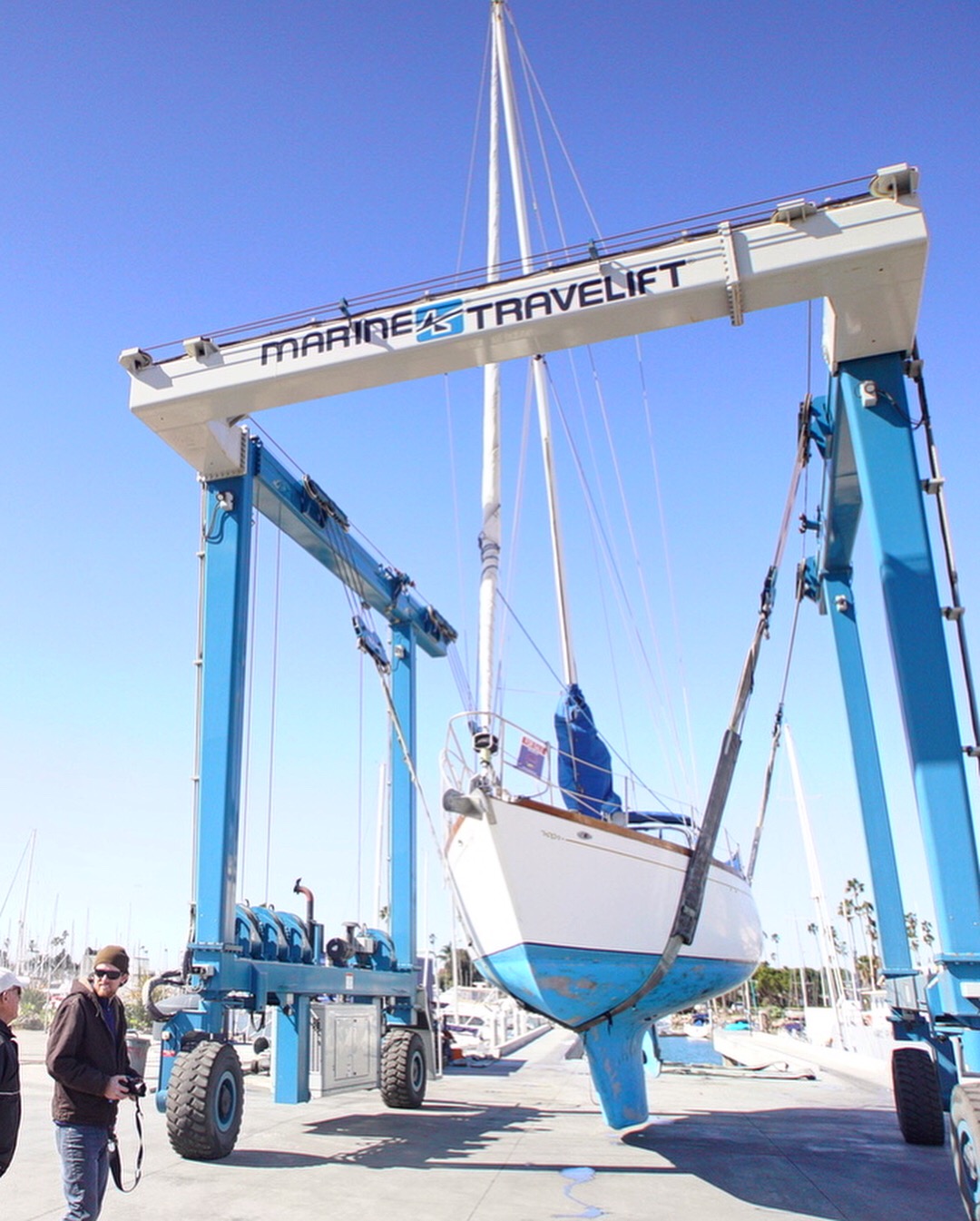
Our first haul and hang during our pre-purchase survey in 2018
I keep playing that scene on repeat in my head. The sound of power tools surrounds me and tears me from my blissful daydream dropping me firmly back in reality. Day 28 in the Ventura Harbor Boatyard, we have come so far but we still have work to do. When we bought Avocet in 2018 we knew that a boatyard date was imminent. The boat’s topsides where last painted around 15 years ago without primer which over time lead to unsightly spider cracking along the entire boat. What lied beneath the water line was as expected; Avocet’s 10-year-old bottom paint was ablative and essentially non-existent when we became the new crew so it wasn’t shocking to see the patches of missing paint when Avocet was pulled out of the water.
In addition to painting Chris and I had plans to complete our new bulwark design that would take the place of our failing toe rail. Avocet had a few leaks when we first came on as crew and we fixed a majority of them, however, since the leaks under the toe rail were unreachable we could only “bandaid” the issue with a bead of TDS along the inside and outside joint of the rail from bow to stern. The TDS lasted as a temporary fix until we had the opportunity to remove the toe rail and begin preparing for the next version of Avocet’s deck upgrade: a proper bulwark. Weeks prior to our haul out, Chris and I had removed our teak toe rail by cutting it into 12-inch sections to remove the through-bolts and fill the voids. There were 200+ through bolts and 188 of them were broken off at the deck due to dissimilar metal corrosion, the cause of our leaks. Once we finished removing the rail and cleaning the mess below deck from the bolt holes falling through, we were ready for our stay at Ventura Harbor Boatyard.
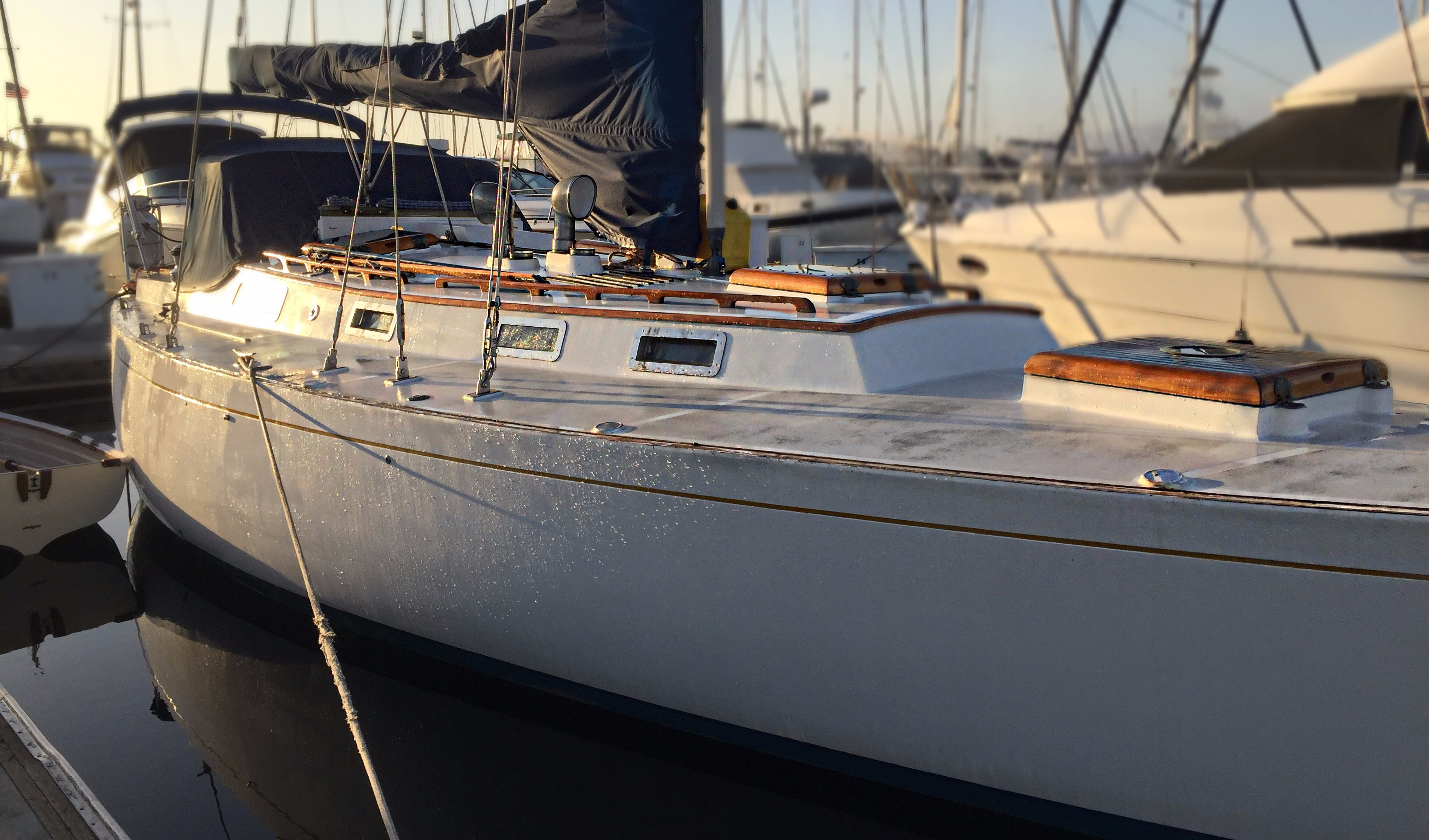
Avocet looking a little naked without her toe rail. Deck to Hull joint fully exposed.
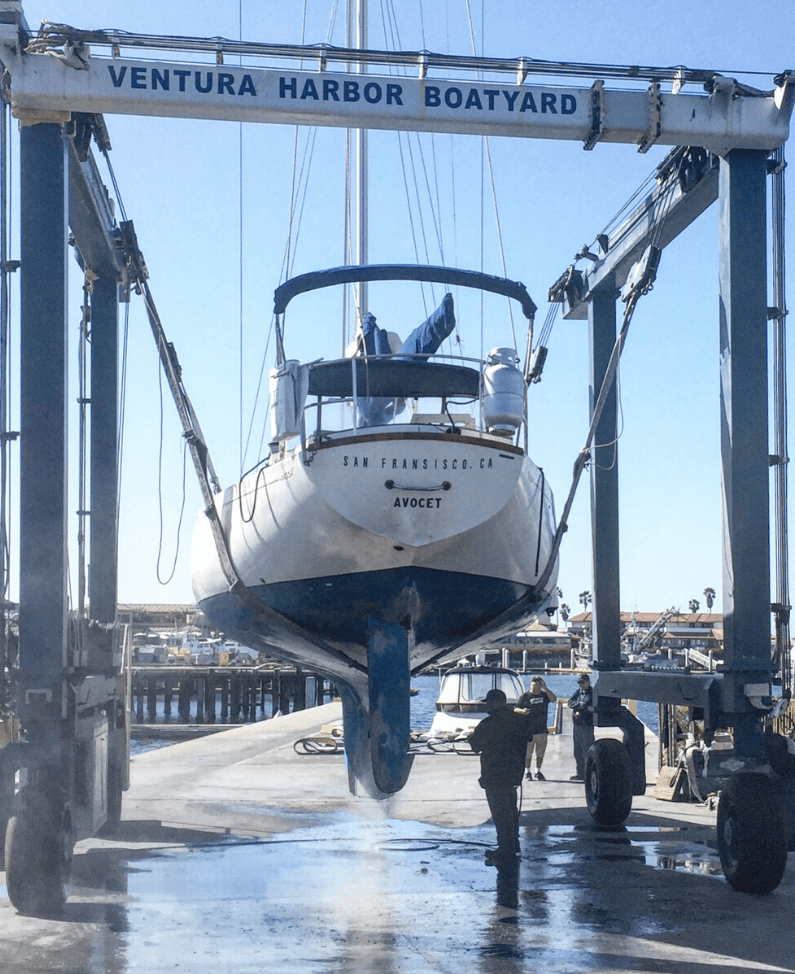
Our haul out 2020
When the day came to lift Avocet onto the hard Chris and I were both anxious. The last time we saw Avocets underbelly out of the water was in 2018 when we were surveying her trying to decide if she was going to be out home or not. Let me tell you, watching Avocet be lifted out of the water was a whole different feeling this time around. 2 years of our lives were built into that boat and watching our livelihood be lifted 10+ feet out of the water made us feel extremely uneasy. Luckily the Ventura Harbor Boatyard is extremely professional and made us comfortable with our choice to haul out in their yard… even when the lift operator asked us to remove the backstay so the lift could properly raise us; Chris attached 2 halyards to the stern cleats as a safety measure.
Once we were landlubbers, Chris dropped our rudder and began assessing the damage for the days to come. We knew we had blisters but my god we had no idea we had Big Bertha, which is the “fun” nickname we gave to the unsightly hole Chris drilled through our keel into the ballast. Big B started as a blister, but unlike other blisters, Bertha just kept weeping no matter where we drilled around her. Eventually, Chris hit dry ballast (hoorah!) but unfortunately Bertha was now a 6-inch hole into our keel which was just the beginning of the horror. We had always believed our ballast was lead but since Bertha was weeping rust we began to think that Avocet may have an iron ballast, which was devastating since this could potentially turn into an even bigger project.
“If the iron ballast is compromised you are in threat of having the keel split due to the iron reacting with the water and rusting. The only way to fix that is to take out your cabin sole, chip all the old ballast until you find fresh glass, and then pour new ballast- preferably lead- which won’t be cheap.” Having your older brother explain your potential doom is like having a comedian tell you that you lost your job – slightly more comforting but still absolutely awful. As the Neely brothers spoke about an action plan from 2,647+ miles away I could see the color in Chris’s face go white. When the phone hung up we decided to carry on with blisters and let Big Bertha dry out for as long as possible, then circle back after researching our options and making a new game plan.
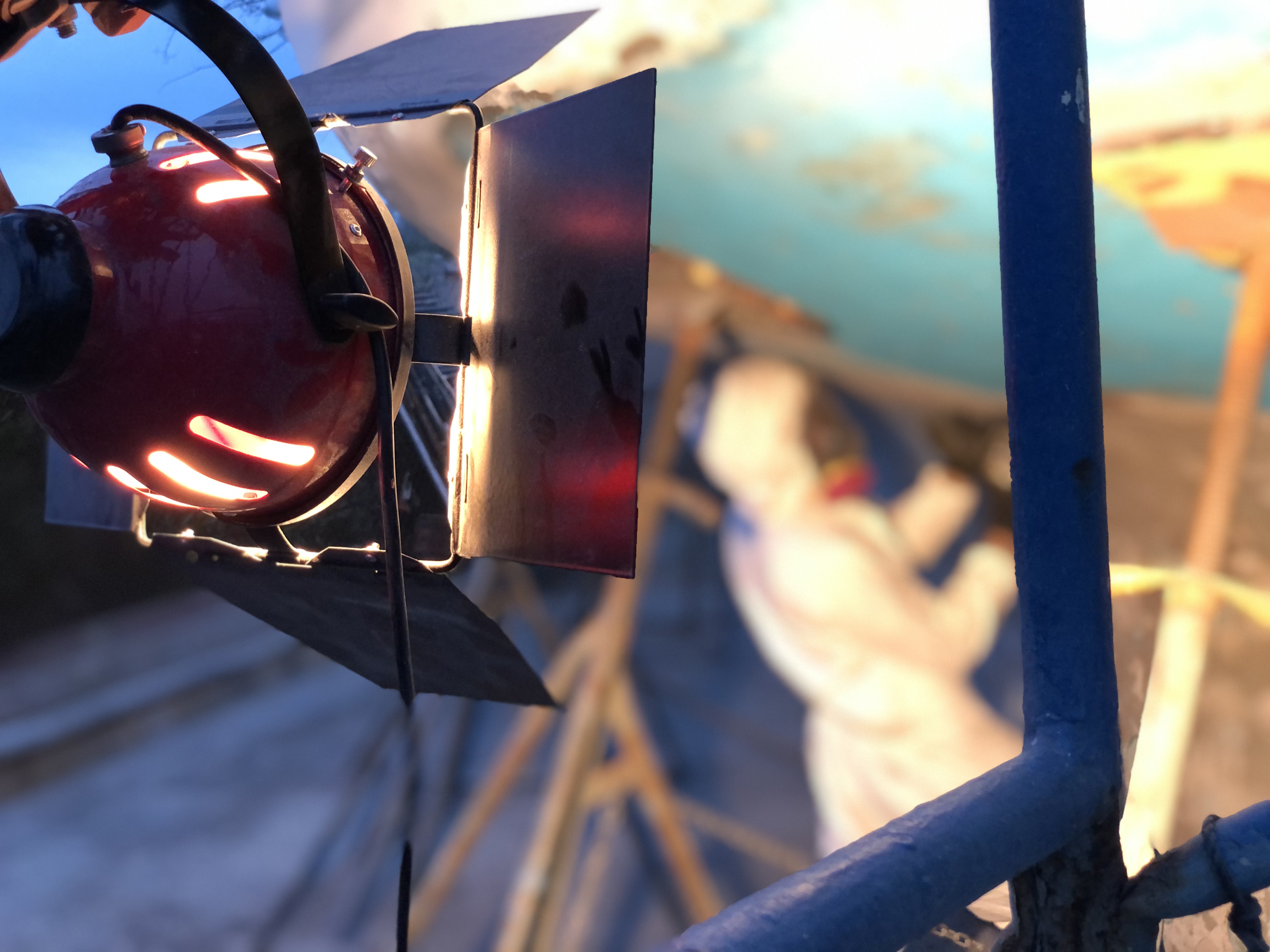
Glorious, glorious sanding! 8:00 a.m. – 9:00 p.m.
If I have learned one thing throughout this haul out it is how much I detest sanding. No matter how much you sand, you will always have to sand again or sand something else and quite frankly I am not patient enough to find any sort of rhythm in that process. Luckily we did not suffer through it alone and we are extremely thankful to have had a few extra hands help out along the way making the project go by faster than originally planned. HUGE thank you to our friends Mallory and Mike A. who lent themselves to the mercy of Avocet’s project list. It took about 2 weeks to completely sand the bottom down to bare glass/gel coat, working from 8:00 a.m. to 9:00 p.m. While Chris focused on finishing the bottom, I directed my attention to our rudder. Since the rudder was off I took the pleasure in paint prep which would also be our test run of the whole bottom paint process. Of course right as we got into a groove and had steady progression we hit a speed bump which turned into an avalanche of bad luck.
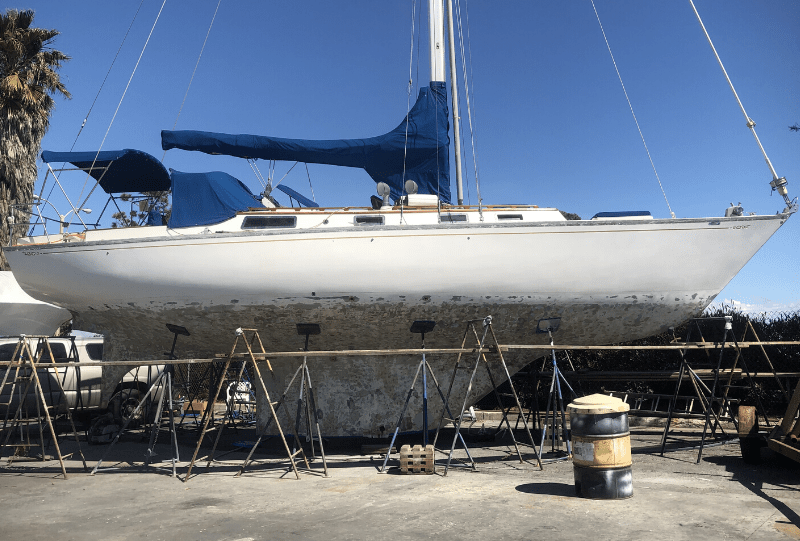
Sanded!
If you read our previous blog post you know that my Dog, Sierra, who was 11 years old passed away on Friday the 13th from cancer. When we returned home to Avocet after an emotional trip to my family’s home, we picked up projects where they left off and continued… just with heavier hearts. Within days of our homecoming, the governor of California announced that the state has issued a shelter in place order to aid in the battle against COVID-19, an ongoing novel in itself. It was like being in a bad dream; the whole world at war against something it couldn’t see. Chris and I were pretty isolated in the yard previous to the shelter in place so we didn’t see the effects right away. As time pressed on the usually busy path along the harbor grew quieter and the people who did venture out wore masks, similar to our respirators used to fend off the boatyard particles. It was a strange time to be alive, and an even stranger time to be in the boatyard. In the dark unknown brought by COVID-19, we stayed positive with memories of freedom from our landlocked location; and now I know why the caged bird sings.
With our heads down and more determined than ever to be floating again Chris and I carried on with projects. Since the bottom was sanded and blisters were drying out we directed our attention towards the next item on our list. As mentioned before, when we removed our toe rail prior to our haul out we discovered 80% of the bolts holding down the toe rail (and more importantly our deck to hull joint) were corroded to the point where the broke off at the deck. We knew that our toe rail needed attention, but we had no idea how bad it really was. Since the old toe rail was intended to be a structural unit, we took extra precautions when designing version 2 of Avocet’s deck to hull joint and bulwark. After a lot of research, Chris had stumbled upon a bulwark design used for many years primarily in old English pilot cutters, but most recently improved by Lyle Hess and implemented in his designs of the Bristol Channel Cutter 28. After a bit more research we had concluded that we would be using a modified version of the Lyle Hess design rather than constructing another toe rail where we would be redrilling holes into our deck.
While in the research phase Chris came across a post from SV Far Reach, which shared a complete restoration and redesign of a Cape Dory 36. They did fantastic work but what caught Chris’s eye was their implementation of bulwarks and a glassed over Deck-to-Hull (DTH) joint which further inspired Chris’s ideas for Avocet. After visually combing every photo Chris had a well thought out approach to our new design and felt confident moving forward with the project.
When we posted project updates online and spoke with passerby’s in the yard, we often were met with comments like “wow that’s a big job” or “just buy a new boat!” leading us to the realization that boat projects like this that involve redesigning the DTH is not very common since it is the very “thing” that is holding the vessel together. Like all the projects on Avocet, we have 1 goal: to make everything more simple, stronger, and safer as a whole. With those 3 key elements in mind, Chris mapped out the perfect plan. The DTH joint was glassed completely on the interior so by fiberglassing the joint on the outside, it would add strength back to the joint as well as stabilize the questionable surface left by the 200+ bolt holes. After careful consideration and experimentation, Chris found that two layers of 1708 fiberglass with Epoxy resin would be the best way to seal the now exposed DTH joint while creating a beautiful seamless connection between the hull and deck.
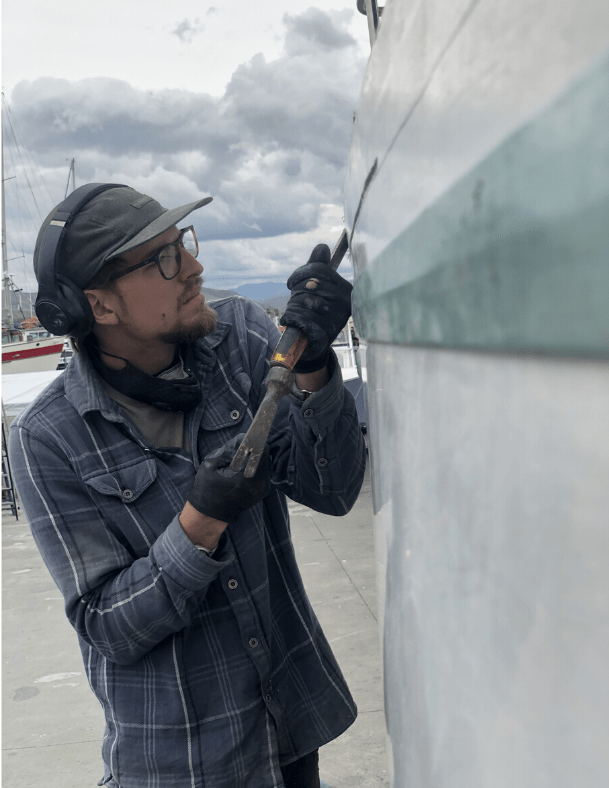
Chris removing what the router couldnt reach
To start this project Chris used a router to remove three inches of fiberglass on both the hull and deck. With 1/4″ of deck and hull material removed the 2 layers of 1708 and fairing compound would be inlaid perfectly. Before glassing, we used a round-over bit on the router to create a soft curve on the edge from the deck to the side of the hull, which is not only aesthetically pleasing but it also allows the 1708 to have a solid bond without any voids caused by harsh 90-degree angles under the glass. With our DTH project going so smoothly we almost forgot about our troublesome little blister buddy Big Bertha.
While working on the Deck to Hull joint, we couldn’t stop thinking about the impending doom of our potentially compromised ballast. Towards the end of glassing, the DTH joint Chris had an epiphany in the midst of celebrating a job well and realized that there was a very simple thing he could do to test the make our ballast and all it took was a magnet.
Unlike Iron, lead and stainless steal do not have a magnetic pull. Chris’s epiphany sparked a sense of hope which inspired him to bring a high power magnet up to the exposed ballast and see what destiny awaited us. The magnet didn’t pull from his hands and dropped from the ballast when he touched the two together and with that sudden thunk on the ground,d we felt a wave of relief wash over us as we concluded that our ballast was, in fact, lead, leading us to our next big question: why does Avocet have a lead ballast whereas a majority of other Cheoy Lee’s are iron and concrete?
After speaking with Cheoy Lee Shipyards directly we think two things that could have happened. The first being that Avocet’s original owner had specifically ordered a lead ballast (thank you!) and the second being that Cheoy Lee threw any scrap metal laying around into the ballast and we got lucky with lead scrap. On paper, we have an iron ballast but a magnet (and outside expert opinions) don’t lie. Whether it be 100% lead or a mix of lead and miscellaneous metal scraps, we are happy that we won’t need to replace any ballast… knock on wood.
With our minds free from our ballast scare we were so excited to reseal unsightly Big B and get on with glassing blisters. Chris had left heat lamps on Bertha to ensure the void was completely dry before filling it with closed-cell foam and glassing many layers on top. Once Bertha was filled, glassed, and faired it was my job to glass the rest of our blisters. I truly have come to enjoy glassing, it is sort of therapeutic. Measuring the glass, cutting it, mixing the epoxy, wetting out the glass, and finally laying the glass in the blister so it would fit perfectly… the process became a rhythm I was proud of my work because for once it was 100% mine. If you had asked me 5 years ago how to repair a blister I would have no idea where to begin or how to even identify a blister. I have nothing but gratitude for Chris’s patience and dedication to teach me how to think creatively as well as objectively to repair things on Avocet.
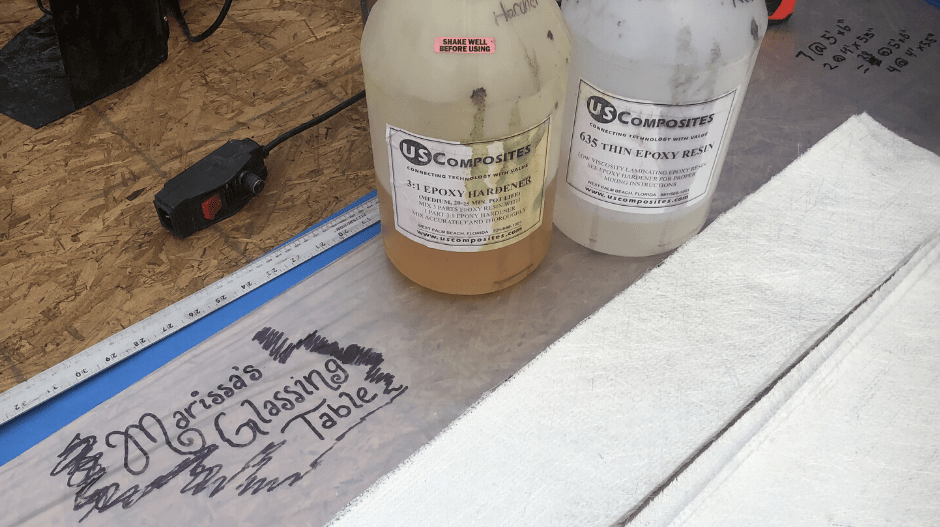
Around the time we were fairing the toe rail, our friend Mike L. stopped by and asked if we would be interested in house-sitting for a week or so while he escaped to the desert for some proper social distancing. Even though we were doing just fine living aboard in the yard, the thought of in-home-laundry and a warm bath enticed me and we agreed to look after Mike’s home and care for his cat Smokey in his absence. Cleo was thrilled to have another cat to play with, which was reassuring considering the last male cat she had interacted with was little Atlas-the-Boat-Catlass some months prior, and to say the least, she was not a huge fan. Smokey and Cleo became good friends chasing each other around the house and Smokey continuously trying to win Cleo’s affections. It was nice to have an opportunity to wash all of our upholstery, clean the fridge, and of course, sanitize everything given the pandemic – a proper deep clean. Mike’s home became our base camp for the following weeks, allowing us to separate “work” from “rest” a bit easier.
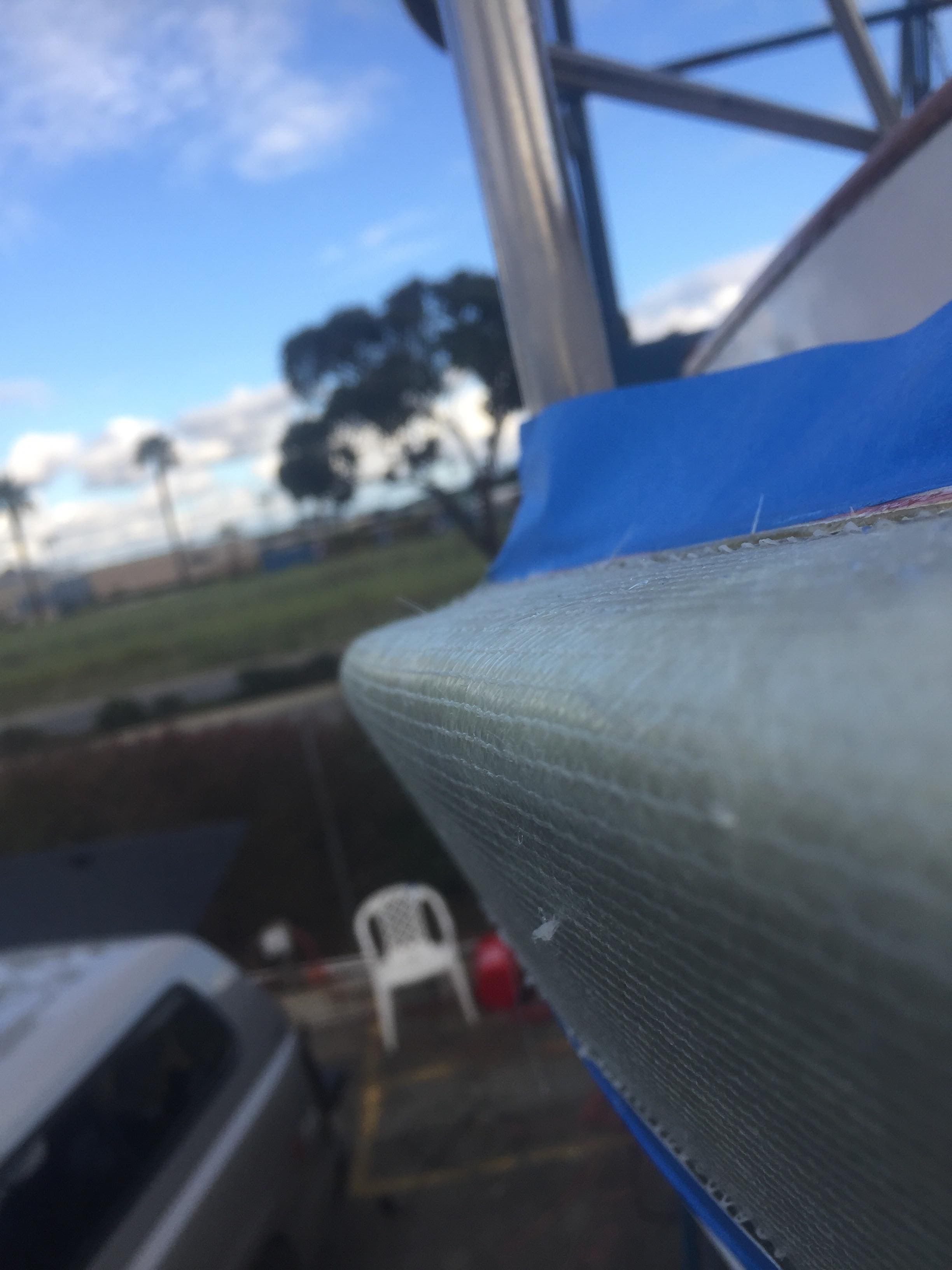
Transom DTH Joint glassed
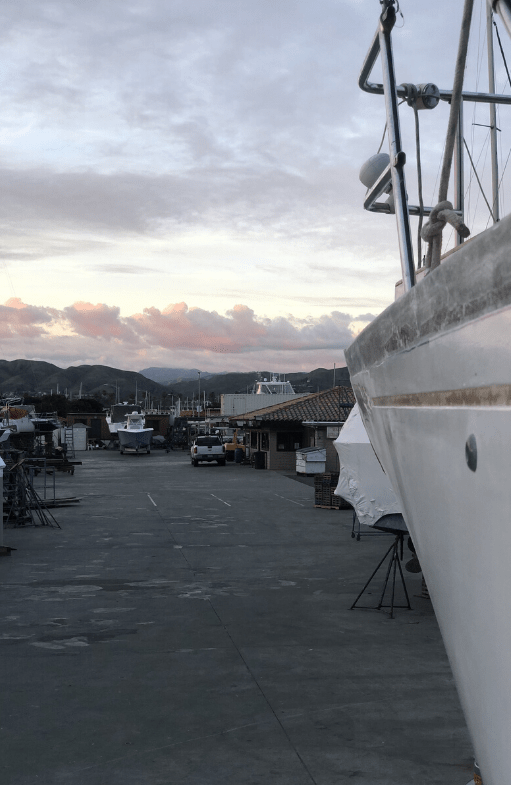
boatyard views
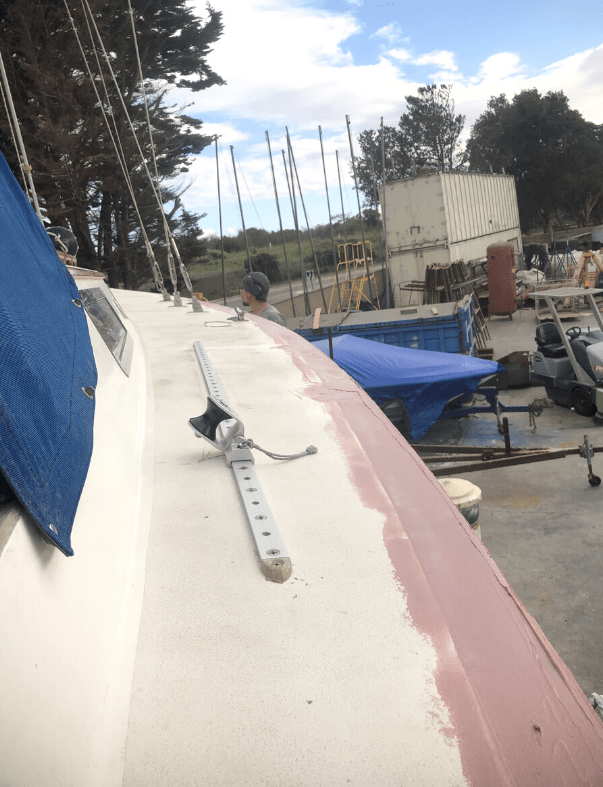
beginning to fair the DTH joint
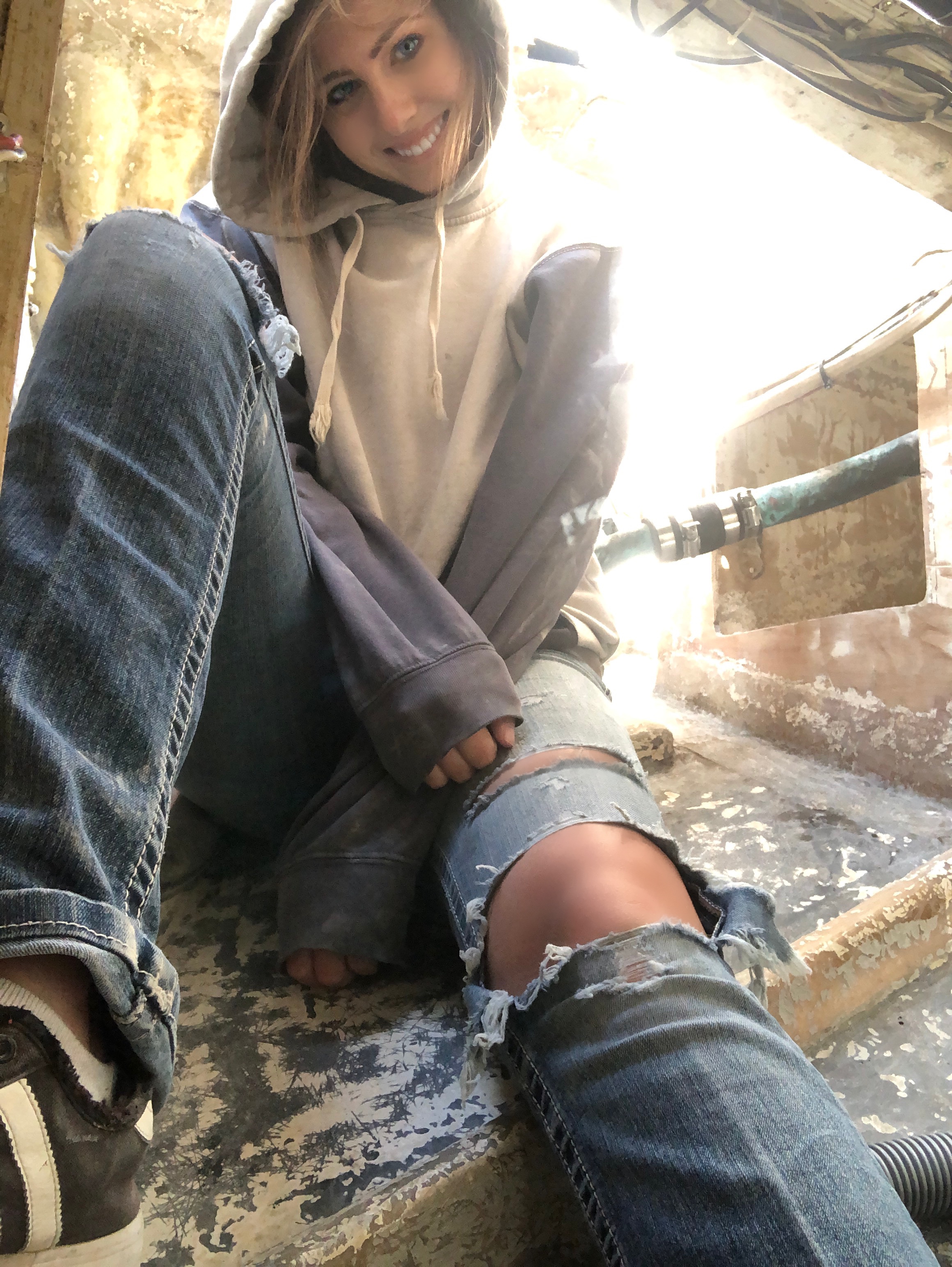
post-panic attack smiles
As we got closer to painting, the yard told us that they needed to move us to a new location away from the road where they would be able to spray the boat, which worked out better for the audio on our videos anyways. Once we were settled in our new and final yard spot Chris suited up and jumped into our lazarretts to grind all the old chipping paint off to prepare to repaint with a clean Rustoleum white. It is truly an art to be able to fold and contort your body to reach small places on a boat, many people refer to this act as “boat yoga” and it is nothing short of that. Chris asked me to paint while he did other projects so while scrunched inside the lazarretts I had music playing to prevent my anxiety from sending me into a panic attack. I have never experienced claustrophobia before, but our boatyard experience really pushed our limits. When I first crawled into the lazarette, Chris joined me to get footage. As I was explaining what I would be doing I started to get jittery, and my heart began to pound. Watching the tape back you can see my face completely change as the panic onset. When I got out of the lazarette Chris assured me he would paint the rest, and I wouldn’t have to go through that again. Knowing there was much more work to be done I said: “no, I got this” and reluctantly pulled my mask back on and jumped back in, music blasting in both ears. Surprisingly the Black Sabbath station was just what I needed to get through that mental roadblock, and I was able to paint the whole locker panic-free.
I managed the blister repairs, sheer line sanding, and various smaller projects while Chris focused on longboarding the topsides- which turned out to be the most labor-intensive and mentally challenging part of the whole haul out. In fact, it was such a pivotal point in our haul out (especially for Chris) that I am going to let him write about his experience sanding for 32 hours straight… so, enjoy the read!
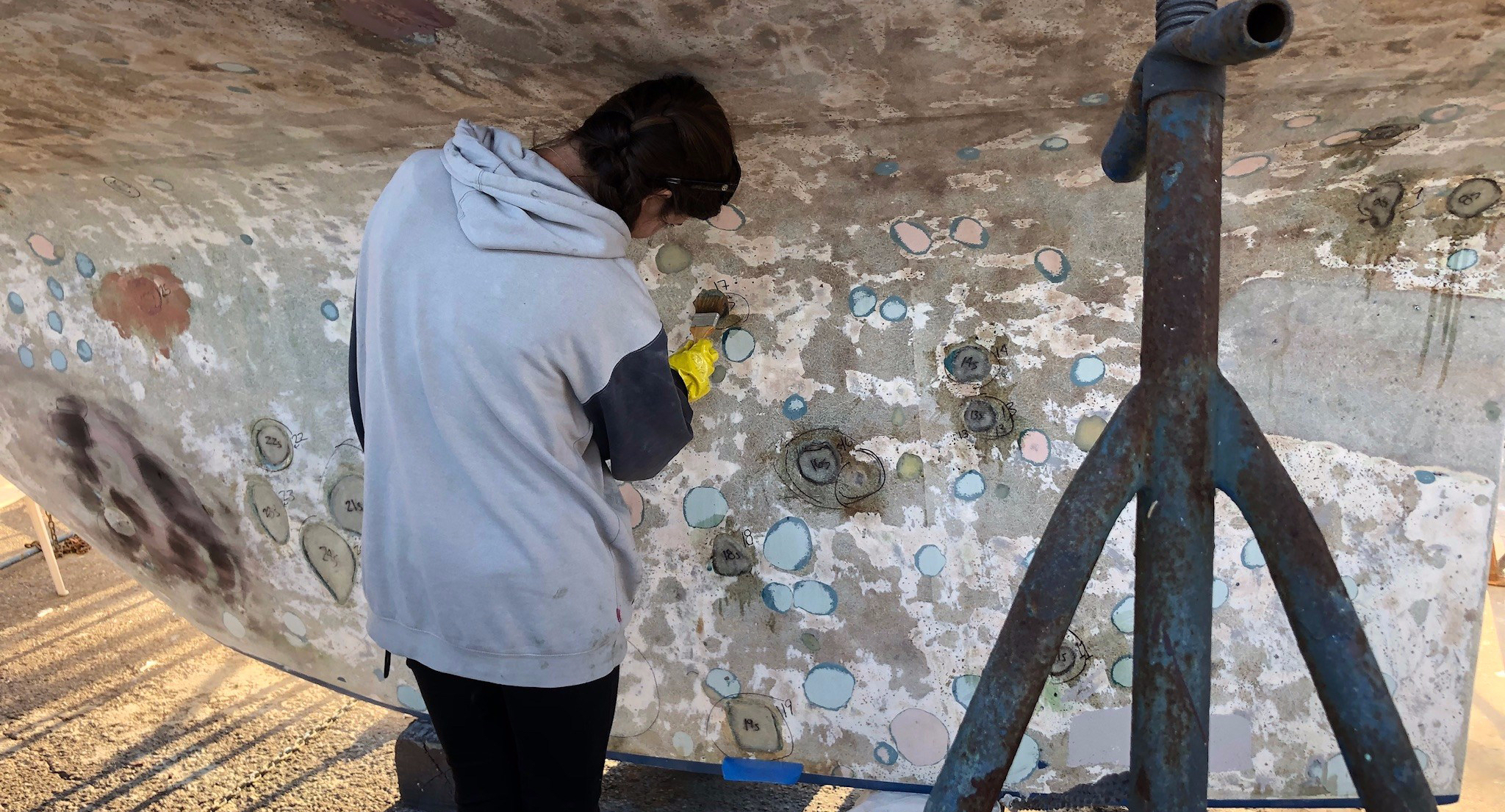
repairing new blisters. the pink and blue spots are old repairs
32 Hours of Glorious, Glorious Sanding – a memoir, by Christopher T. Neely
Despite our preparations, we didn’t factor in the unpredictable weather. It was a month of rain showers, constantly delaying our plans. With the pressure of COVID-19 and our wallets bleeding we needed out of the boatyard ASAP so we could seek safety on the water. When I saw that the weather had changed and we now had a solid 2 days of sunshine I knew that was our new paint window; we had to get the topsides prepped and painted within the next 2 days or who knows when we would have had a chance to paint again, especially since the Awlgrip paint requires at least 7 full days to semi-cure before we could be put back in the slings. The full curing time is near one month.
Monday had been my tentative shoot date, so we worked all weekend to get the topsides and deck ready. Despite working from 8:00 am – 10:00 pm/11:00, come Sunday night it was pretty clear we had a long way to go. We pushed our paint date to Tuesday, giving us one more day to work hard, hoping that by nightfall we would have everything taped up and ready to shoot in the morning. After sanding all day long with no breaks in between I looked at Marissa and told her to go home and that I would at least be home by midnight. She had work the next morning and needed to get some sleep, especially since she was our only source of income at the moment due to COVID-19 causing all of my scheduled work shoots to get canceled. Although she protested, by 10:30 she agreed to go home and have dinner waiting for me.
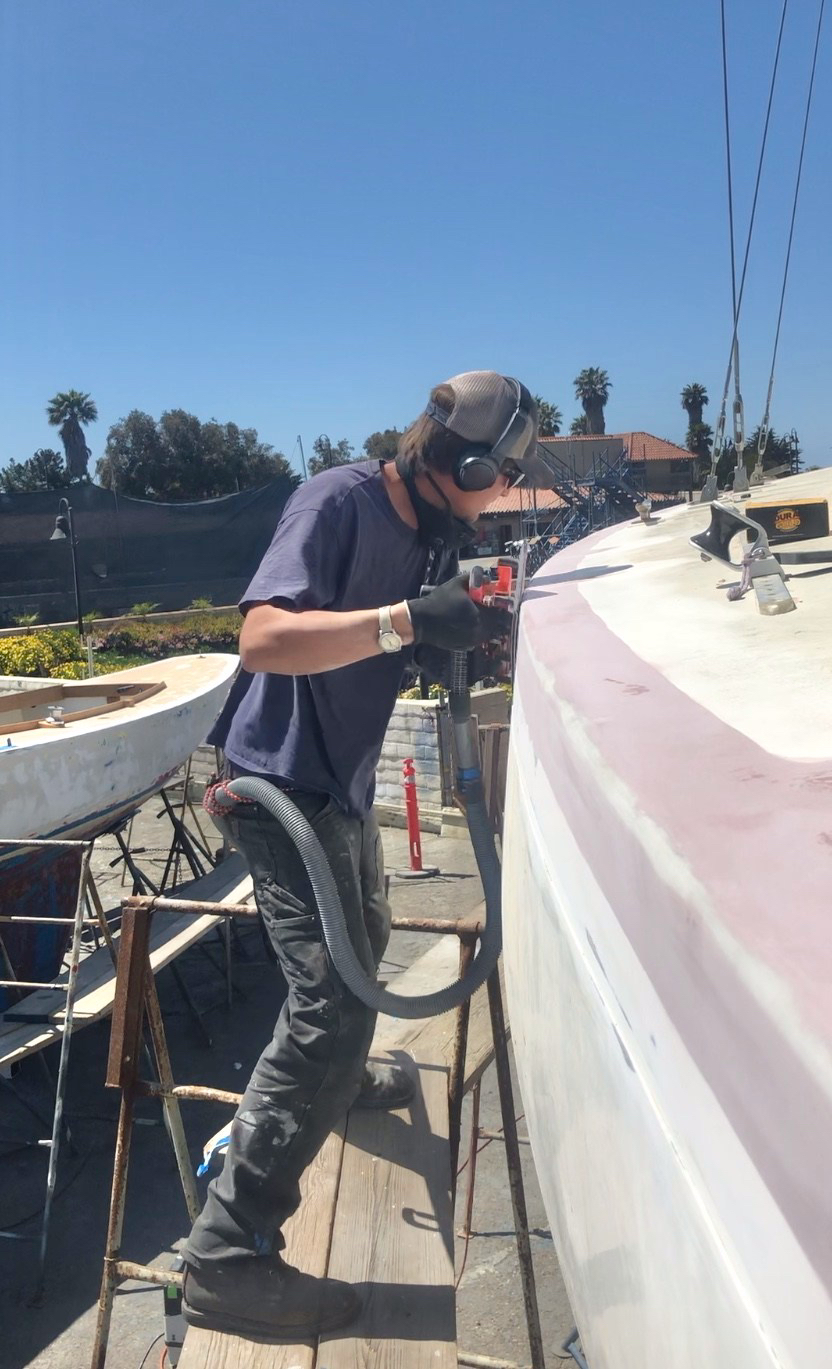
Flexi sander
The rest of the night became some sort of a blur after Marissa left. I had already been sanding for 14 hours, and the closer the clock got to midnight the more numb my hands felt. I kept Rage Against the Machine blaring in my Bluetooth headphones, a gift from my brother, and the night pushed on. It was the equivalent of a runners high, I reached a point where adrenaline took the wheel and I just kept sanding; back and forth, back and forth, the flexisander and I became one solid machine pushing on to get the desired result.
Every time I completed a section I was hopeful that the next would go faster, but there is no way to speed up hand sanding, its monotonous and time-consuming. By 2:00 a.m. the boatyard was so quiet, not a single soul to be seen, and why would there be? Everyone was home in bed sleeping at that time. Occasionally, I would break my sanding trance and look down at the ocean right beyond our bow, dreaming of being curled up in our nice warm bed, being gently rocked by the sea at anchor.
By the time 4:00 a.m. came around, I was no longer hopeful of getting sleep but was determined to have this boat finished by 8:00 a.m. I clenched my fist to stretch my fingers and felt my blood soak into my gloves. I had an emotional moment where I looked at the bow then looked across the 41 feet of the hull and my thoughts consumed me. We couldn’t win with the weather, COVID-19 was this unpredictable danger, we had so much work to do, our bank account was drying up… as I let my thoughts drag me farther down it truly felt like this was all too much work to continue on, and that there is no way we could finish. I regrouped after battling my thoughts and realized that sometimes you feel the furthest away from achievement when in reality you are so close. After a “fun” 5-minute sob session, I slipped my headphones back on, picked up the sander, and pressed on; not allowing wood and fiberglass to conquer me.
Sunrise greeted my dusty face and I was pleased to turn my headlamp off after replacing the batteries for the third time that night. Although the sunrise was beautiful, I had not finished sanding the topsides yet and wished that I could pause time, giving me just a few more hours before the yard would come alive. Marissa called me at 6:30, alarmed I wasn’t home. I grunted through my mask “still sanding, didn’t stop, come by soon” then hung up. When 7:55 came, I had finished the last of the sanding of Avocets topsides and deck with 320 grit. Even without paint, the hull shined from the prep alone.
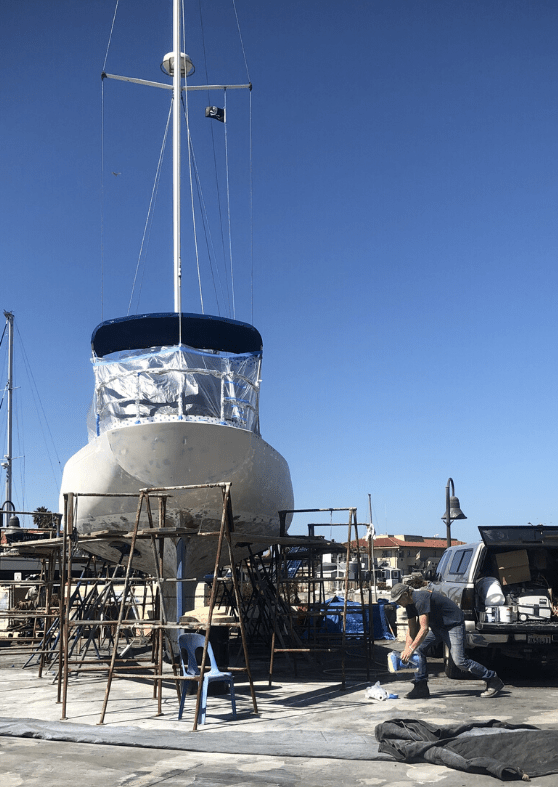
Finally taping off everything and preparing to lift the spray screen
After 25 hours of continuous sanding, I wish I had time to admire my work. Unfortunately, the yard was awake and Johnny who would be shooting our topsides was staging our boat for paint. We had to paint at exactly 11:00, which gave me less than 3 hours to completely dewax and clean the full hull of Avocet, as well as strike the waterline, put a skirt on the bottom, and tarp the entire deck and bottom of the mast so no overspray would get on the boat. The waterline alone can take up to 2 hours…
Marissa and I scrambled to tape off the doghouse, canvas, and everything that shouldn’t be painted. We got busy tarping and taping the entire cabin top which took nearly an hour or so, then Marissa left for work. I was again left to fend for myself wrapping all the stainless on the deck like our shrouds, forestay, backstay, pushpit, and so on. Thank goodness we didn’t have any stanchions or toerail on!
It was about 10:45 and I still hadn’t started the waterline or wiped the boat down. After 10 minutes I struck the best waterline I could; which turned out incredibly well. I must give credit where it’s due, the master painters in the yard took the time to teach me a trick for marking water lines, which I would try to explain here but I would rather just show you in our upcoming videos. After wiping all 80 feet down with microfiber cloths and Awlgrip surface prep, the last step was to tack cloth the whole boat to remove any last bits of dust, lint, and dirt particles. At about 11:45 Johnny pulled the trigger on the paint gun and all the anxiety that had been building inside me the past month had completely vanished.
I drove into the boatyard parking lot after work and my jaw dropped. The sun was setting over the water, shining onto Avocet’s hull and reflecting on our faces. It was the first time we have ever been able to see ourselves in Avocet’s curvacious sides. Chris looked like a whole new person with his relaxed demeanor and smile stretching from ear to ear. We hugged each other and started picking up our work area before heading back to the house for an early night.
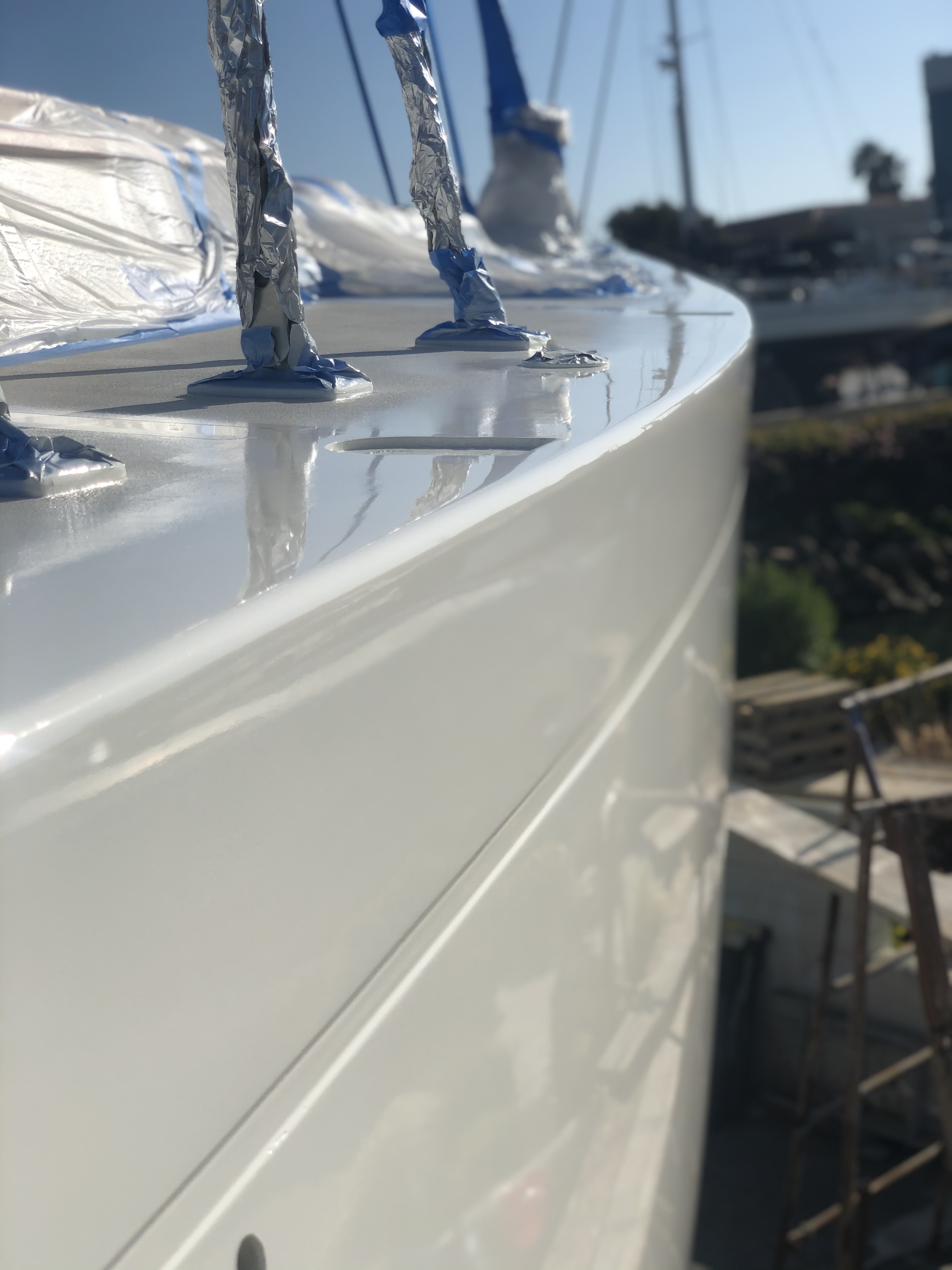
Look at that seamless hull joint... wow!
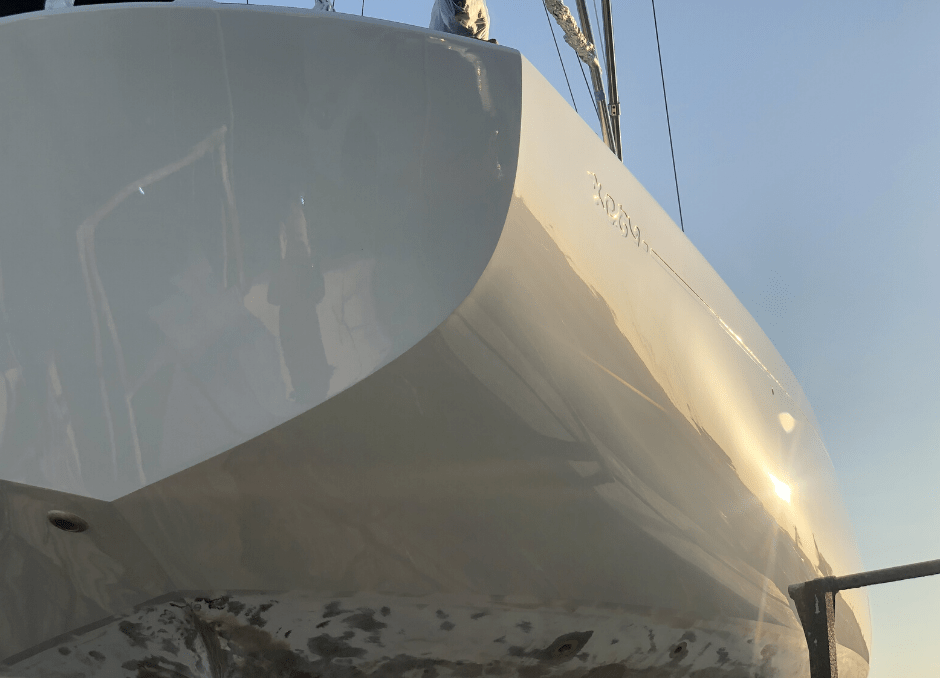
Look at that reflection!
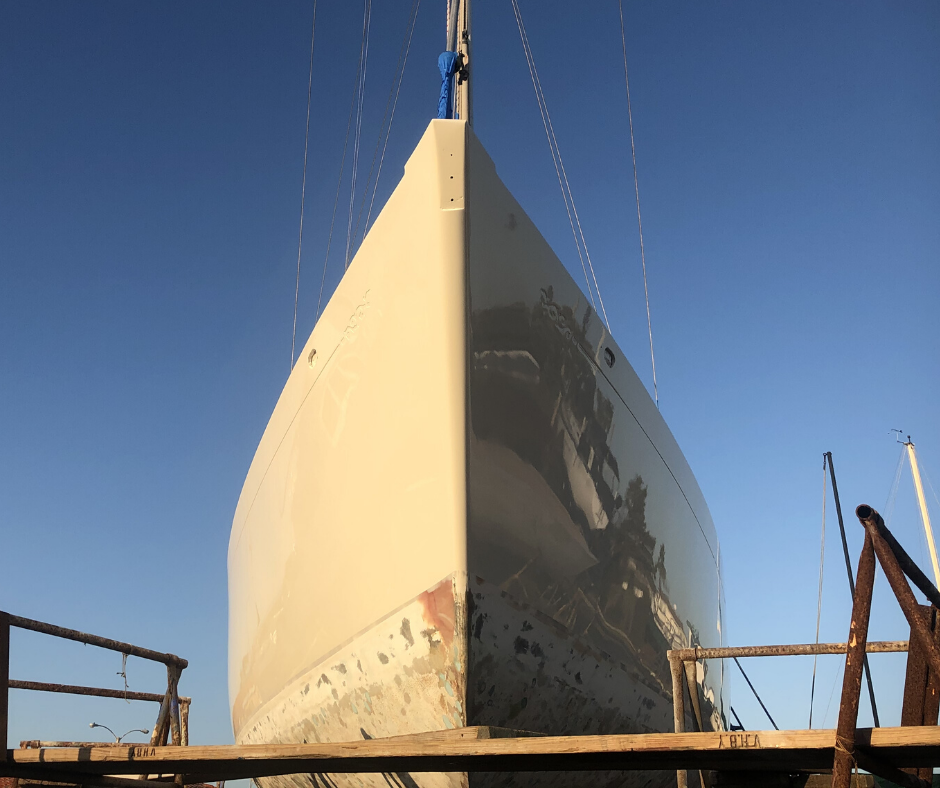
.
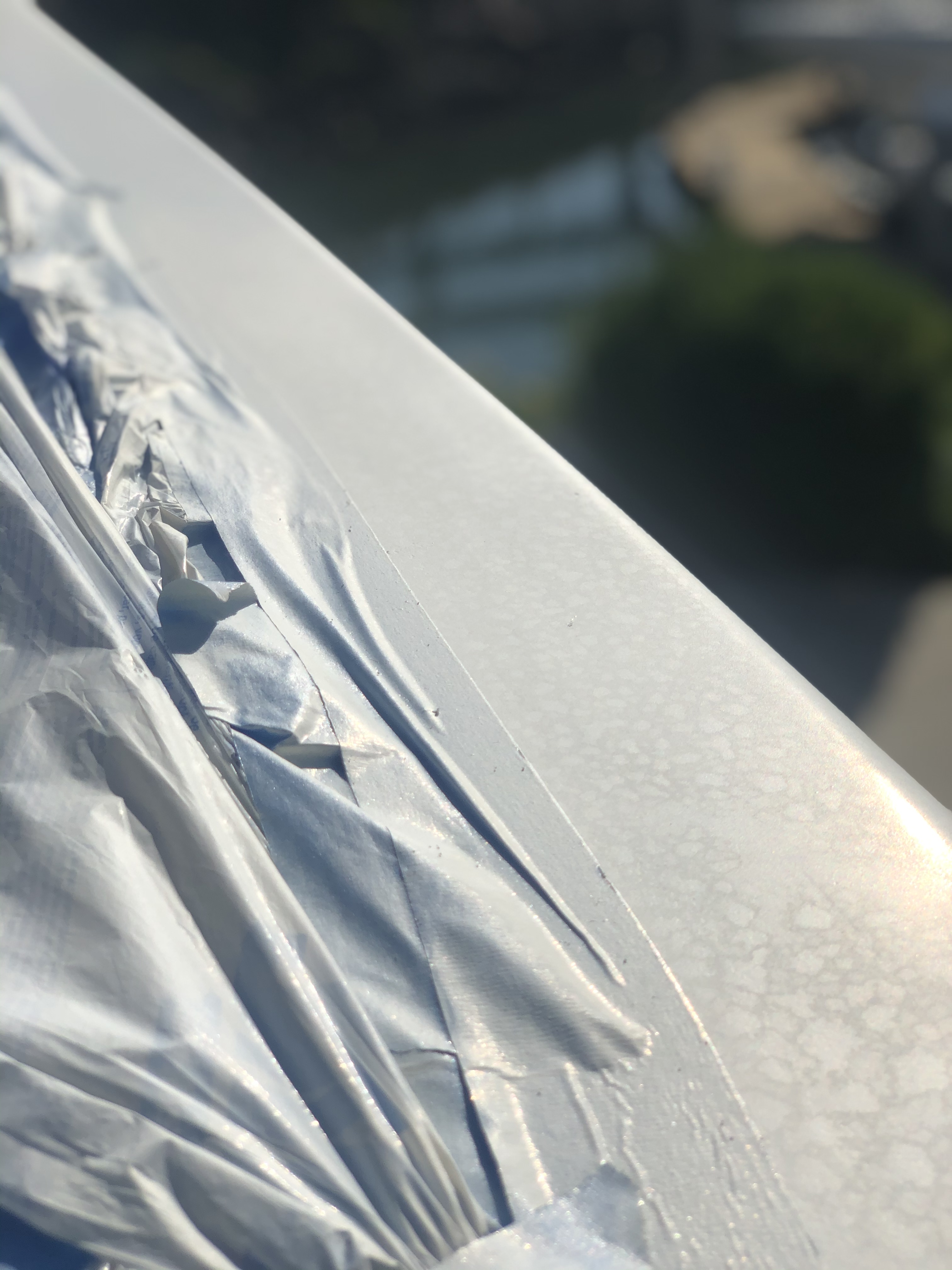
The culprit of Chris’s sadness
The following day Chris had a work which we were very grateful for since it was the first shoot he had had in a month and a half. With him away, it was my job to start taking the painters’ plastic off. Chris called me asking what the status of our paint was and if it still looked amazing. I was happy to report that no hoodlums spraypainted their names on the hull during his 12-hour absence and sent him a photo for proof. Unfortunately, he didn’t see what I did. What I saw was a job well done, a masterpiece, and a physical representation of our blood, sweat, and tears. What Chris saw in that photo was less than poetic. He soon became obsessed and upset with the matt finish on the deck caused by the dew that settled overnight. “If I just had another day it would have been perfect!” he kept saying.
He came home the following day and was fixated on the tiny mistakes that were overlooked by everyone but himself. Passerbys would “ooh” and “aah” at Avocet, giving Chris a little confidence boost but nothing substantial enough to pull him out of his funk. To be completely honest it was driving me nuts to hear Chris belittle his work – our home – so much, and my words of praise were clearly not helping so I reached out to our friends and family for a little help. I had secretly asked our loved ones to send me a short clip of them giving Chris words of encouragement and with their help, I patched together a 4-minute video full of love to share with my husband, Mr. Grumpy Gills. Just as I had hoped, the video had him smiling just as big as the day the boat was painted. After some gentle, honest conversation we discussed the things we could have done better and agreed to move on. Of course, looking back there are things we would have changed, but all we can do is look forward and use the boat as she was intended to be used.
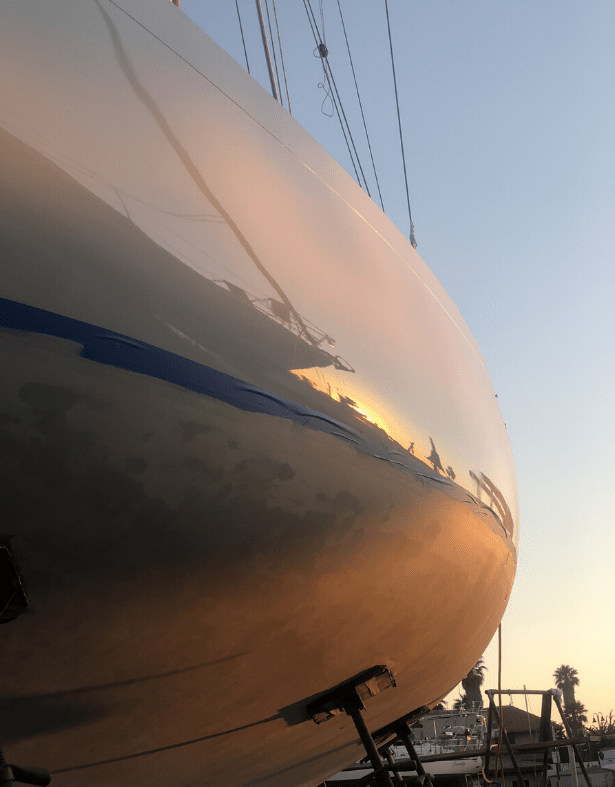
Just look at that shine!
It was still very eerie in the boatyard. It was the third week of the “Shelter in Place” order, and although the yard was still working on government vessels (the reason they were essential) there was still a feeling of uncertainty that blanketed the yard, leaving us feeling like we were in some weird dystopian movie or a matrix. Time pushed on but it felt like we were living the same day over and over… a new fear presented itself to us one day: if the yard did happen to shut down how would we get back in the water? Chris had begun to strategize how to convince the lift operators to splash us if worse came to worse. We felt like we had unknowingly checked into the Hotel California, where you can check out any time you’d like but you can never leave.
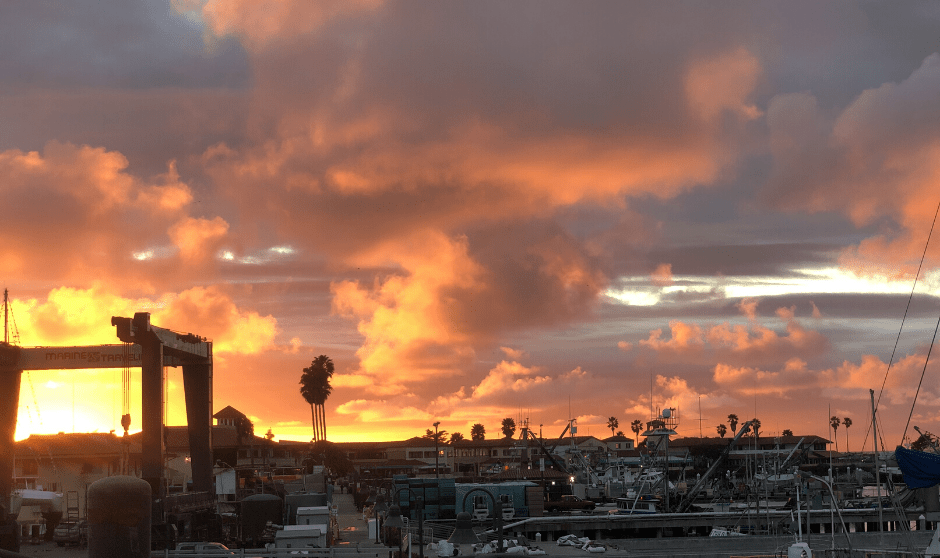
Boatyard sunsets during the “coronapocalypse “
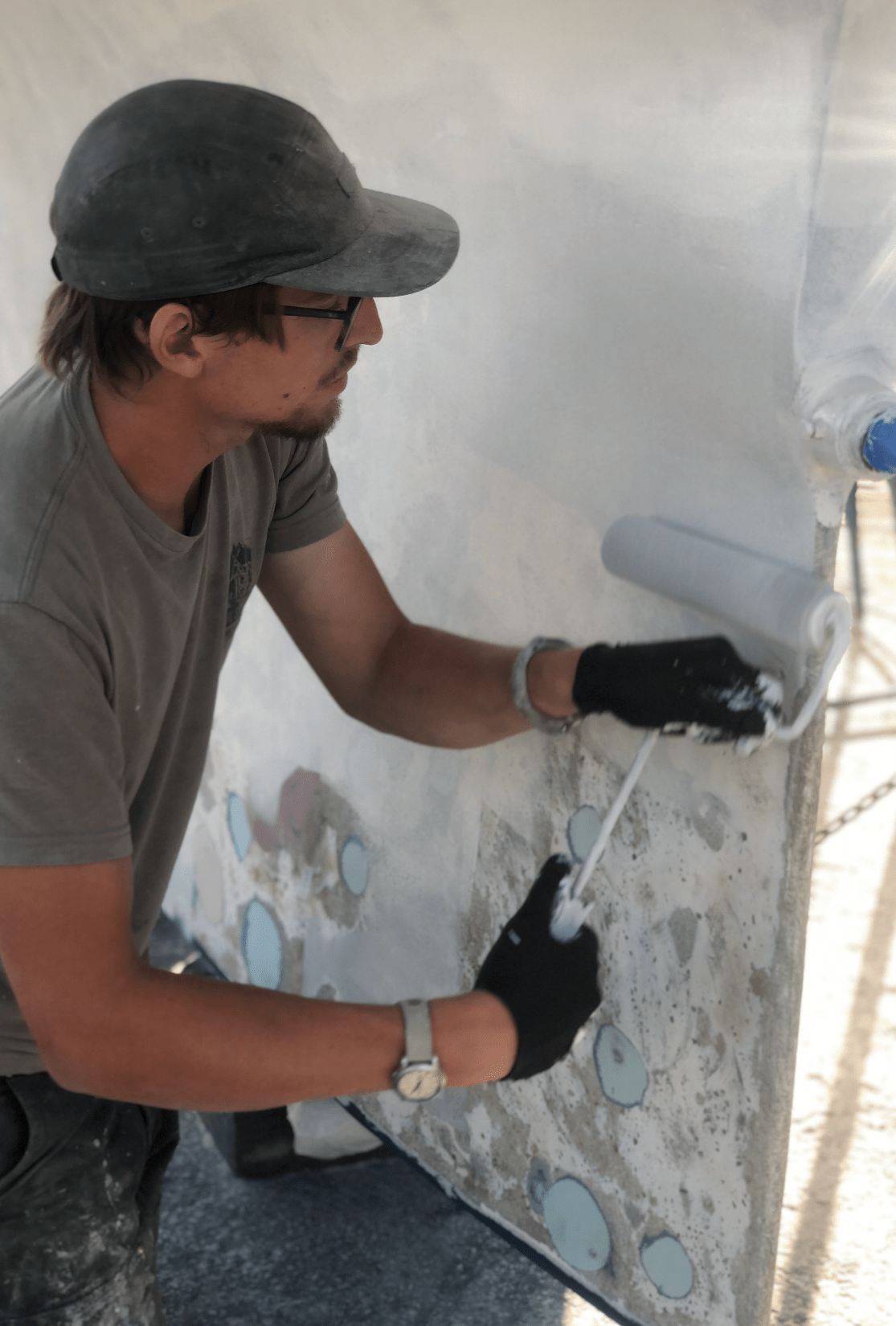
With the topsides painted we could transition to painting the bottom, something we have been excited for since the day we bought Avocet. While Chris focused on making sure all of the blisters were faired perfectly, I was tasked with polishing all of our hardware using our wire wheel and buffing wheel. It was all fun and games until I was applying a piece of buffing compound to the buffing wheel and it got taken from my hands then thrown at me like a high-speed projectile. A block of compound hit me right in the clavicle, which hurt incredibly bad. Despite the pain, I laughed. It was such a comical incident, I could only imagine what a bystander would have seen had the boatyard not been a ghost town. My clavicle and ego bruised, I continued polishing and eventually had shiny cleats and a stem piece to show for it.
Chris rolled the barrier coat on the bottom, working quickly to avoid streaks and harsh lines. As satisfying it was to cover all of Avocet’s bottom side imperfections (like Big Bertha) it was kind of bittersweet in a way to be covering up the evidence of our hard work. I let Chris focus on the bottom while I sanded our binnacle, removing all of the fouled paint. We had initially planned to have the pieces sandblasted and even had dropped it off at the shop we use for sandblasting, but in the early stages of COVID-19 when businesses were closing their doors we acted fast to get our parts back before we couldn’t. Chris had to beg the shop manager to allow him to take back our pieces, unfinished. Begrudgingly, the manager told Chris he would keep the door open for 10 minutes, so Chris was able to bring home our pieces. Fast forward nearly a full month later, I was sanding the parts getting them down to their bare aluminum.
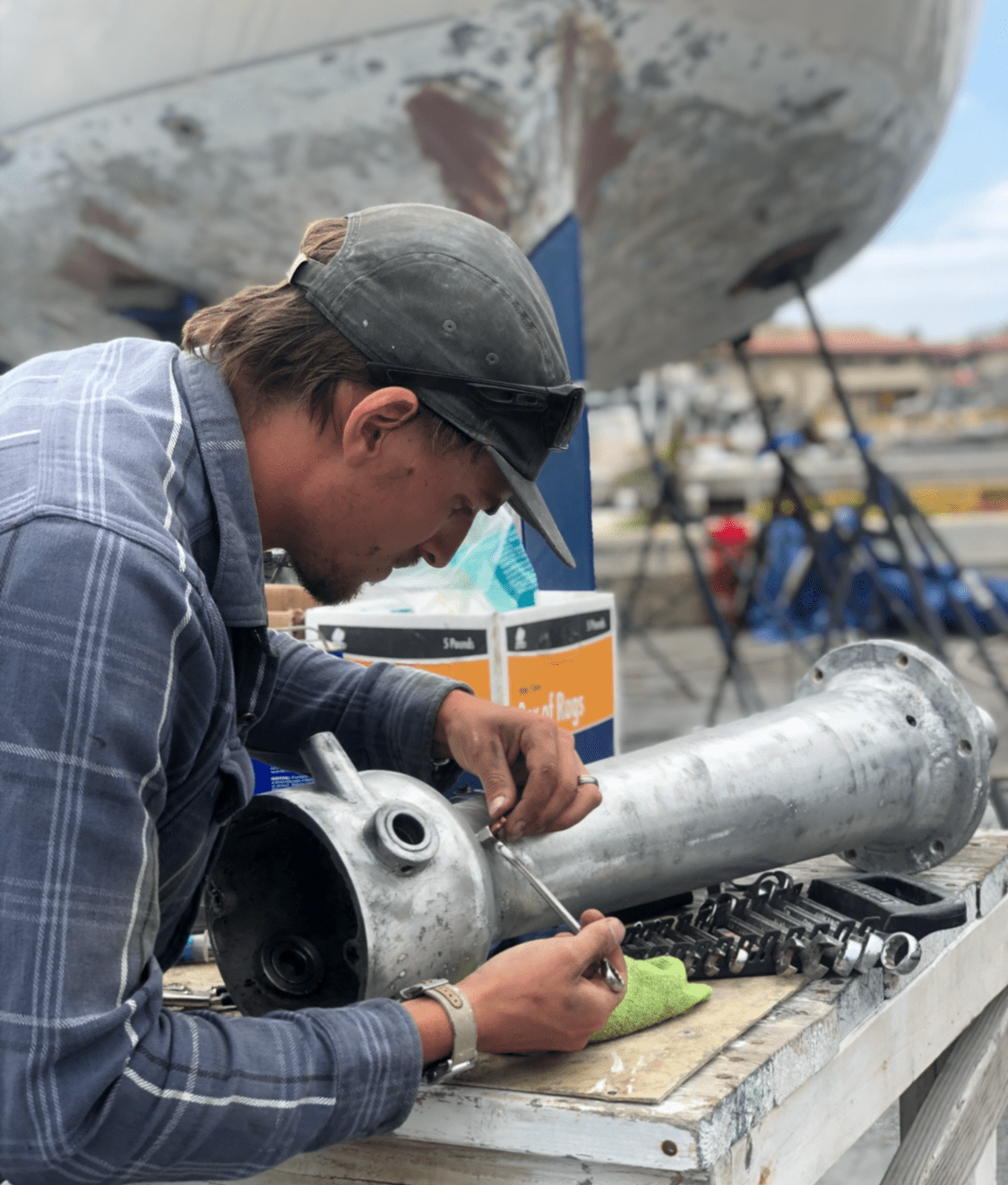
Putting the binnacle back together
Unfortunately, I had work the day Chris painted the bottom, but I can’t even tell you how incredible it was to leave an unfinished boat and come home to a boat that looked brand new. I drove into the boatyard parking lot after my day at work and was smitten with the dark blue bottom complimenting the sunset reflecting topsides. We still had to paint where the support pads were placed on the hull, but besides that Avocet was ready to splash. We slept soundly in our bed that night, eager to return to our life afloat.
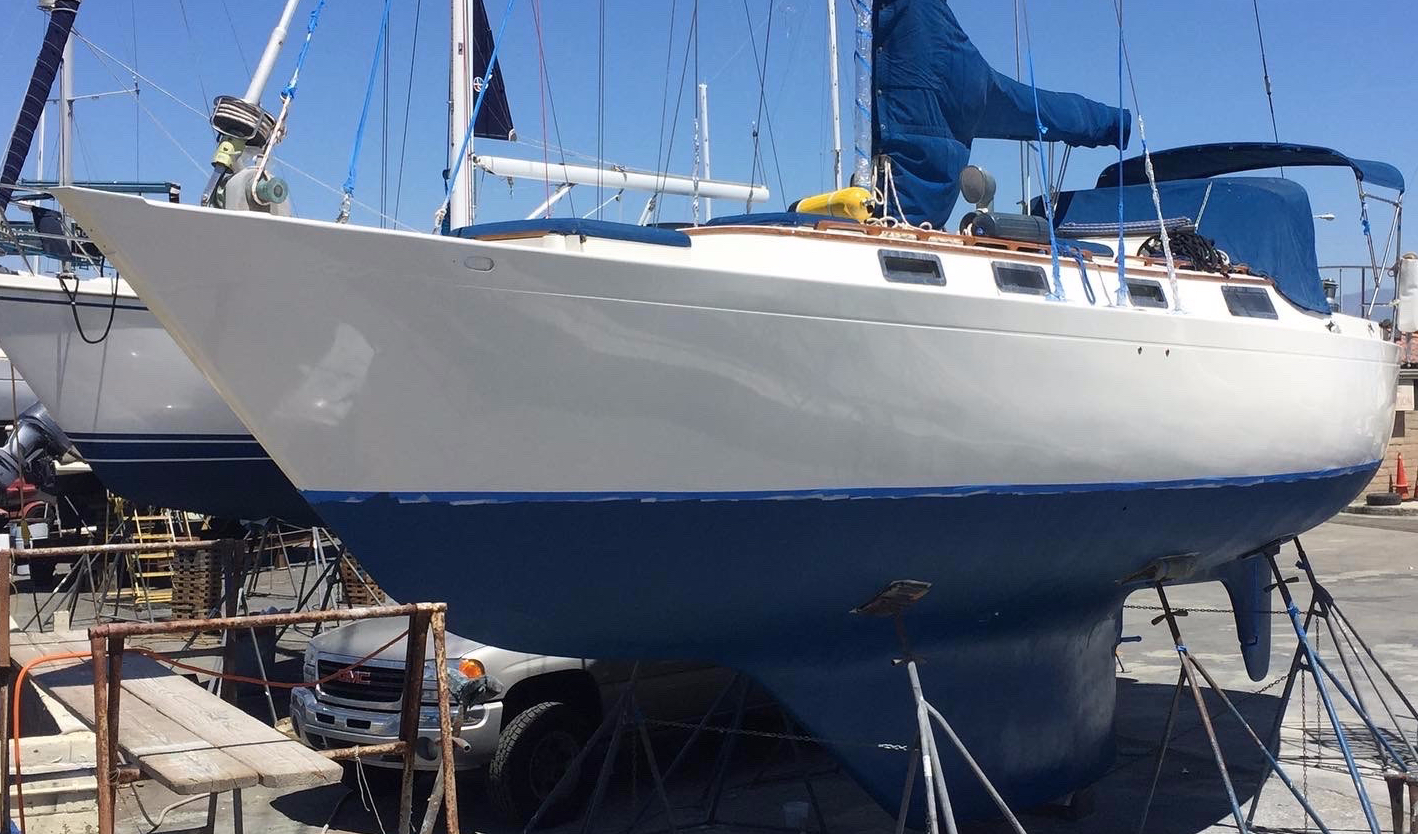
WOW!
The following day we moved back aboard Avocet. Mike and his girlfriend Kris had planned to return home after their month away from society. We spent the morning cleaning the house and packing our things. Chris had mowed the lawn which was something he had never done before since he grew up in the mountains. Cleo sniffed goodbye to Smoky and just like that our suburban home vacation was over. Once we were settled back in, Cleo curled up in the cockpit next to the companionway and we humans proceeded to finish projects.
Together we reinstalled the shaft which we had to cut 2 inches to accommodate our new 3 blade Autoprop which replaced our feathering 2 blade prop. Chris had fantasized about a 3 blade Autoprop since purchasing Avocet in 2018. In the time we have spent motoring Avocet in all conditions, it became apparent that our 2 blade maxprop was not powerful enough for Avocet’s caliber. We had ordered our new prop from Bruntons in January, but due to the virus, it put a stop on all shipments coming from the UK. The prop arrived 1 day before our splash date, just enough time for us to drool over its beautifully crafted bronze blades before sadly painting it with zinc paint for its own protection. A little information about our Autoprop: All propellers have what is called pitch: the degree at which the blades of the prop are bent from the hub. Your pitch is really important because, you can have a different pitch for different circumstances, just like a race car has different tires for different circumstances. The pitch of your prop determines the amount of “bite” you have in the water so a blade with a lot of pitch may work very efficiently at lower engine RPMs, but if you brought the engine very high in RPMs, eventually the prop will start to cavitate in the water (spinning). The pitch is matched with the torque and horsepower of your engine to give you the best output, however, there is always a compromise with a fixed pitch of a propeller.
The special thing about the Autoprop is that it is the only auto pitching prop in the world. Yeah, you read that right, it’s the only one! Bruntons has designed this feathering prop to give an optimal pitch at whatever RPM you have the engine running at. After fitting the Autoprop to our new shaft we couldn’t wait to try it in the water.
At last, it was our final day in the Ventura Harbor Boatyard. We spent the hours by picking up our workspace, painting the final spots where the support pads were, reinstalling hardware, and drinking champagne to celebrate. The Howells joined us for a toast and shared the moment of relief with us. There we were, 2 months later, staring up at a boat that looked brand new. We had come so far and were ready to return to the water. After 2 bottles of champagne and some much-needed comfort food from our friends Mom and Pops Tacos, we relished in our accomplishments and finally allowed ourselves to relax just enough to have the best night of sleep since before our boatyard escapade.
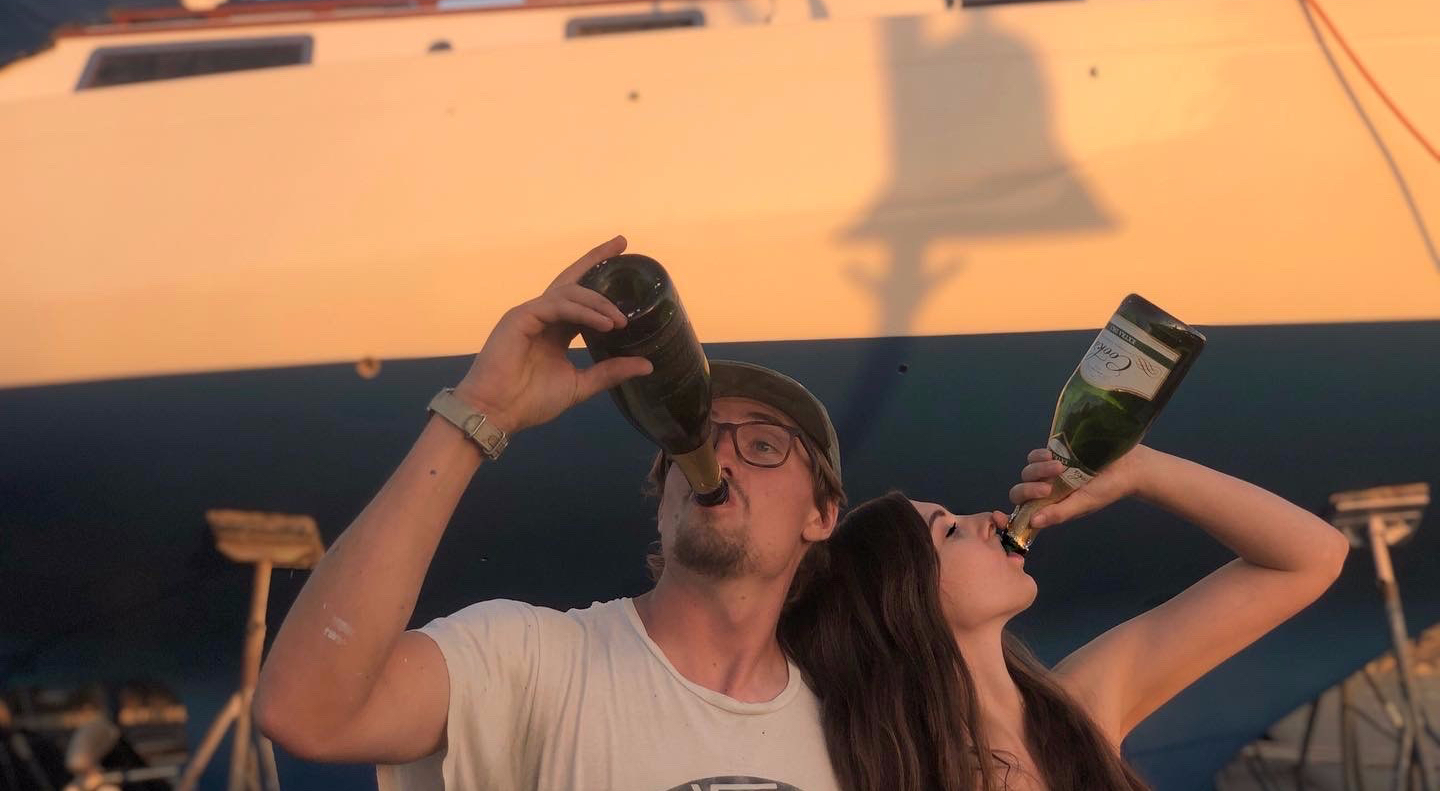
54 days, 6 hours, and 23 minutes later we were returning back to the water. It was our splash day, Avocet was ready and so were we. Chris had all the cameras charged and I was armed and ready with our Instagram Livestream. Watching Avocet be lifted in the slings again was another nerve-racking experience, but somehow this time we were more confident due to our structural support work is done on the deck to hull joint and our new found boatyard friends were the ones behind the lift controls. As Avocet was lowered into the water, a small crowd formed (6 feet apart from each other) to watch. The Howells, Mike and Kris, and even “Mayor” Tom joined to watch the glorious moment. Cheers, claps, and laughter went around when Avocets hull finally splashed, our newly raised waterline sitting perfectly on the water. Cody, who was operating the slings, gave Chris a high five before he and Daryl removed the slings. They said it was rare for DIY’ers like us to not have any issues when the boat splashes (i.e. packing gland and through-hole issues) but he wasn’t surprised that we were in good shape, the “boatyard boys” had seen how much work we had put into Avocet and by the end of it, all had become friends of ours.
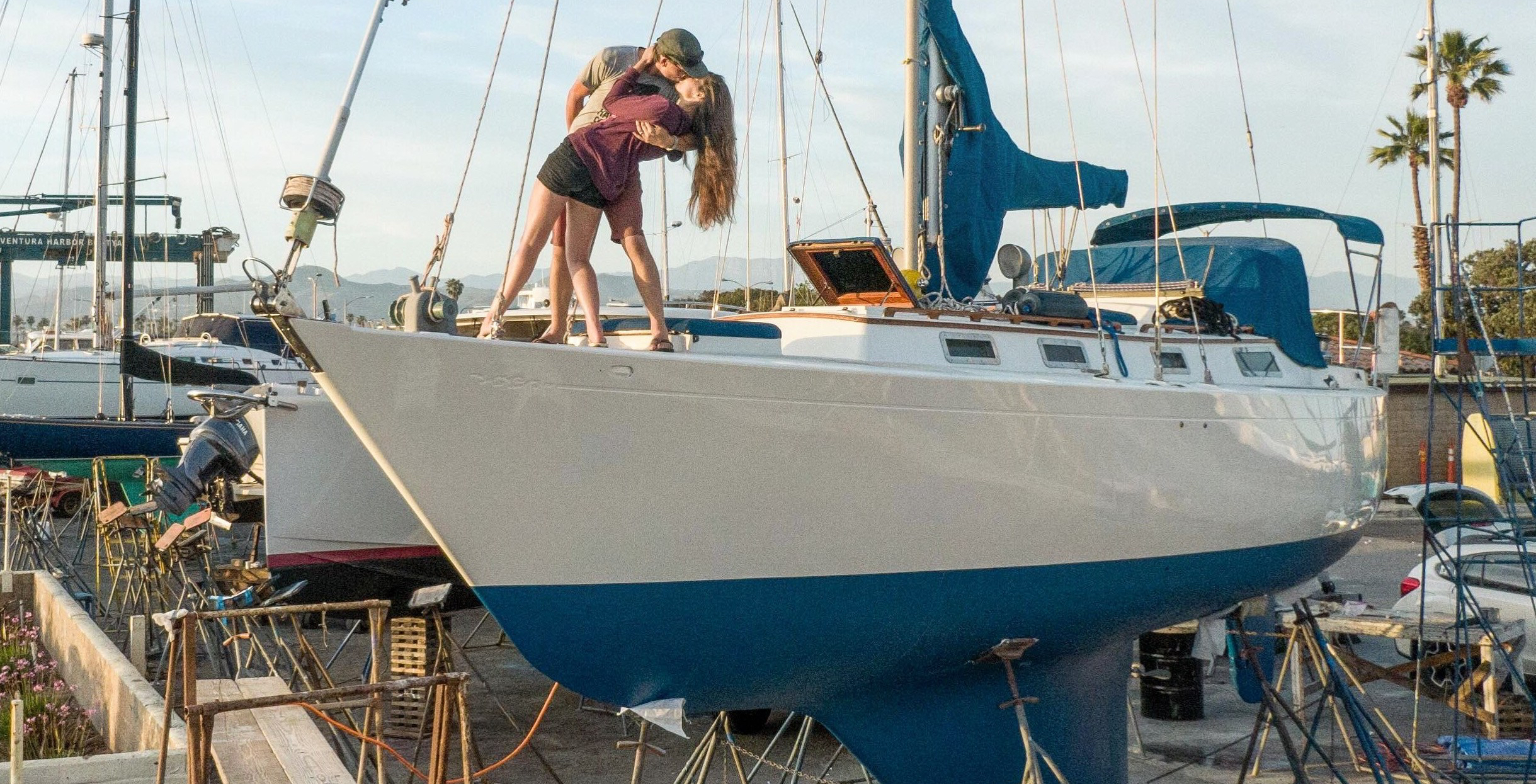
WE DID IT!
Absolutely thrilled we decided to take Avocet for a victory lap around the harbor, to test our sea legs and new prop. In gear but in idle (12-1500 RPM), we were pushing along at 4.5-5 knots which was a significant power change from our last prop which we could barely get 6kts when at 2500 RPM. After a few laps and princess waves to passing boats, we returned to our slip where we were so careful to back in. We stuck the landing with no issues and just like that life was back to normal – well, for the most part. Our dock neighbors all crawled out of their boats to say hi and welcome us home. The subtle hint of movement brought life back to Avocet. Our oil lamps gently swayed back and forth ever so slowly as if the boat was breathing. Our bed had never felt more comfortable and despite our excitement, we finally let the exhaustion in and were sound asleep by 9:30.
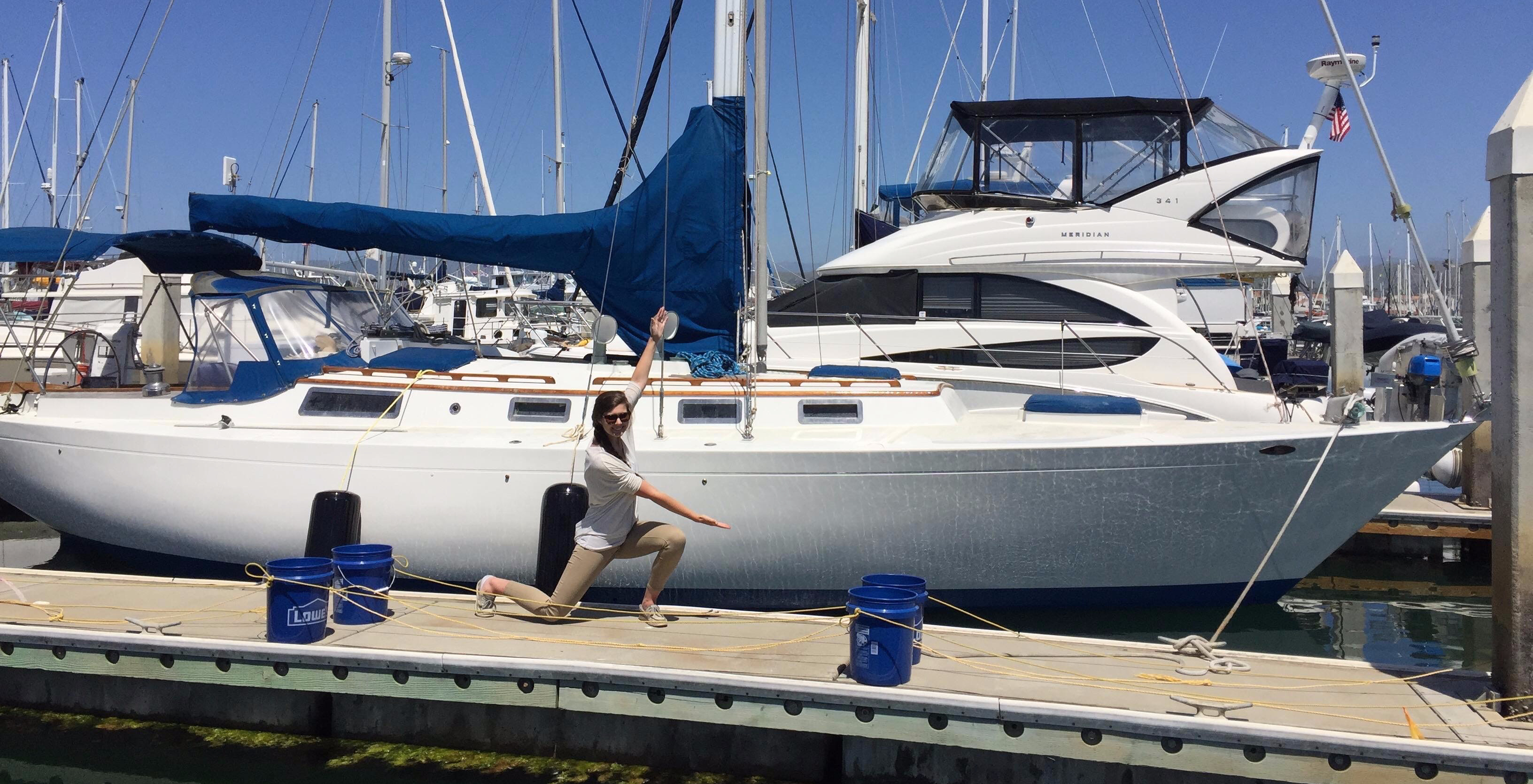
The sunrise woke me up around 6:00, now that our bow was back facing towards the east. Every morning the sun hits me perfectly on “my side” of our bed, through our staterooms portlight window. I gladly accepted the warmth on my face and let Chris sleep while I began typing this blog on my phone. I eventually got up and started the coffee, moving to the cockpit to enjoy the morning. I promised myself to never take the little things for granted again. The sound of sanders buzzed in the distance from the boatyard. I smiled and also promised myself to not touch a sander again for at least another month. Chris joined me in the cockpit, looking completely at ease. It was such an odd feeling; we had just spent the past 2 months working harder than ever before, pushing ourselves physically and mentally, yet being back in the water almost erased all of the emotions we had carried with us in the yard. Somehow we had pressed “play” and our lives were back to “normal”. Of course, the pandemic was still sweeping over our world, and it was not something we took lightly, but being home in the water brought us the comfort and security we lacked in the yard.
Although the boatyard chapter of this project is over, we are not finished yet. We still need to reinstall our new bulwarks, paint our sheer line, shoot our decks, redo our non-skid, and of course, put Avocet’s name on the transom. The hard work continues, it just seems a little less hard while floating and for that, we are thankful. Chris and I would like to extend our thanks to anyone and everyone who helped us with this major project; whether it was by physically lending a hand or simply dropping us a line to check in on us. Your support means the world to us, and hopefully, we can all go sailing together soon. Until then thank you so much for following along!
Fair Winds,
Marissa, Chris and Cleo
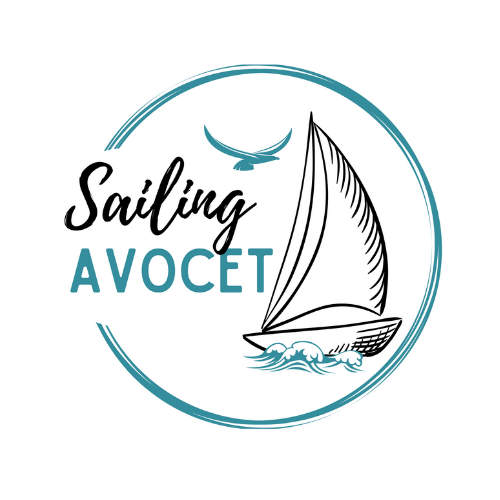


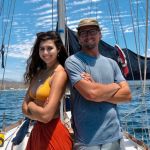

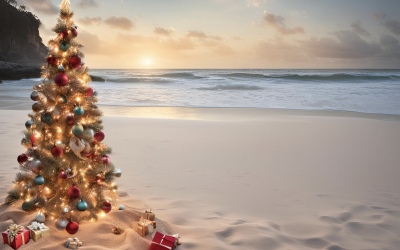
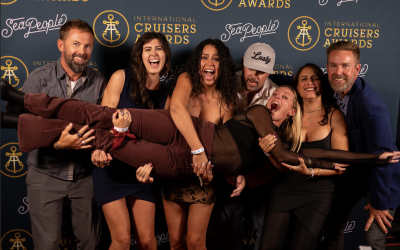
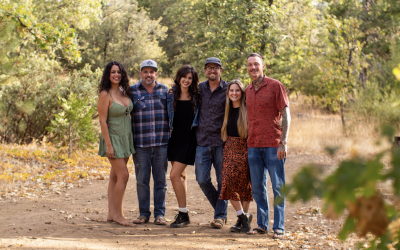
Wonderful write-up even without the recommended strong drink !
Congrats to all three of you for toughing it out. Avocet looks gorgeous ! Can’t wait to see you back out on the water. Seems like an eternity since we ‘cruised’ up to Ventura with you when you moved up there but it’s probably been close to 5 months by now ?
Stay safe and healthy !
-Sven (& Nancy)
[think there is a missing word or typo: “When we posted project updates online and spoke with passerby’s in the yard, we boat projects that involve redesigning the DTH, since it is the very “thing” that is holding the vessel together.” ?]
Oops! Good catch. What on earth would we do without you two. 🙂 sending lots of love!
That paint job looks fantastic!
You folks should be very proud of your workmanship!
Thank you so much, we are so happy with the result!